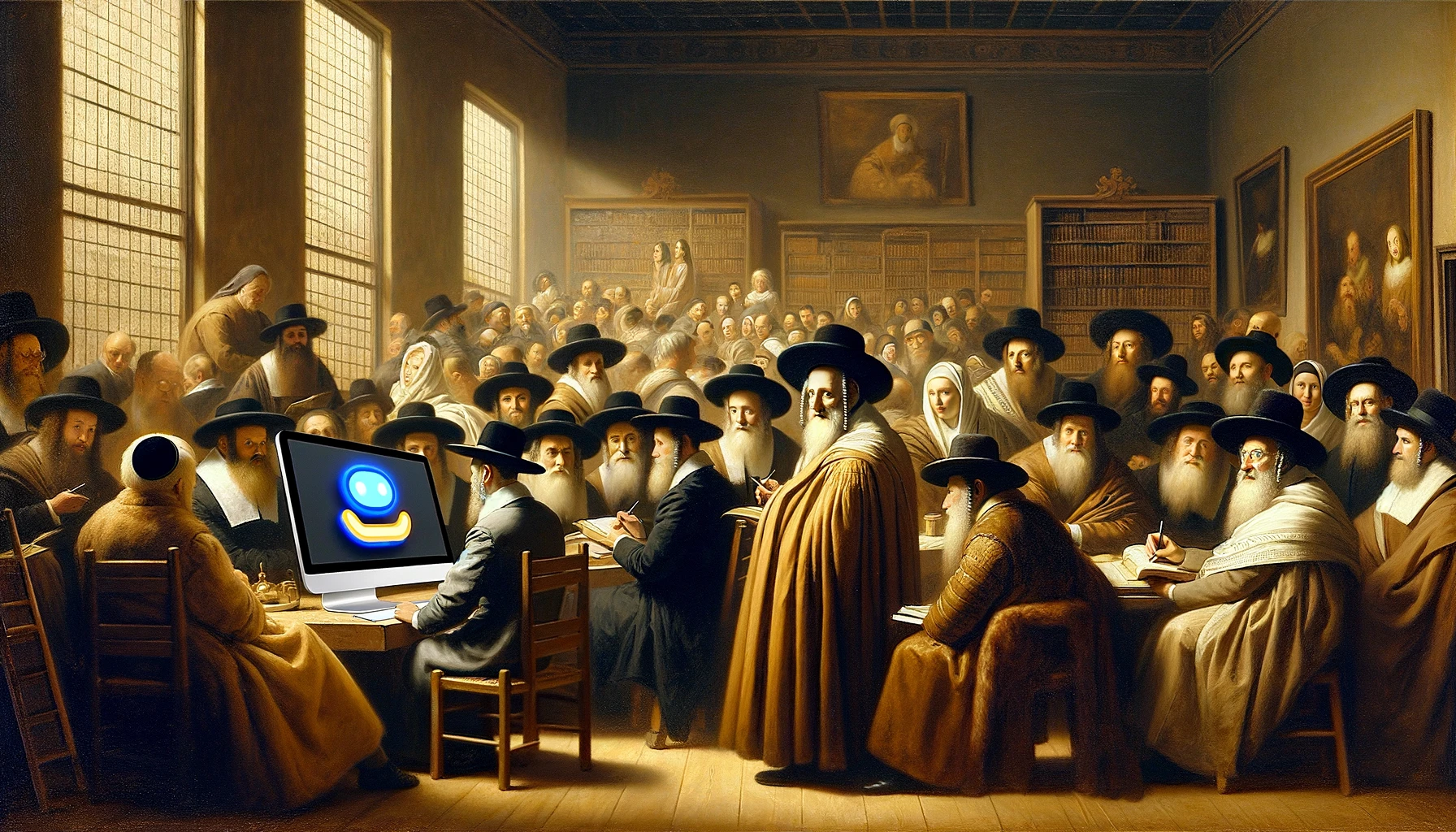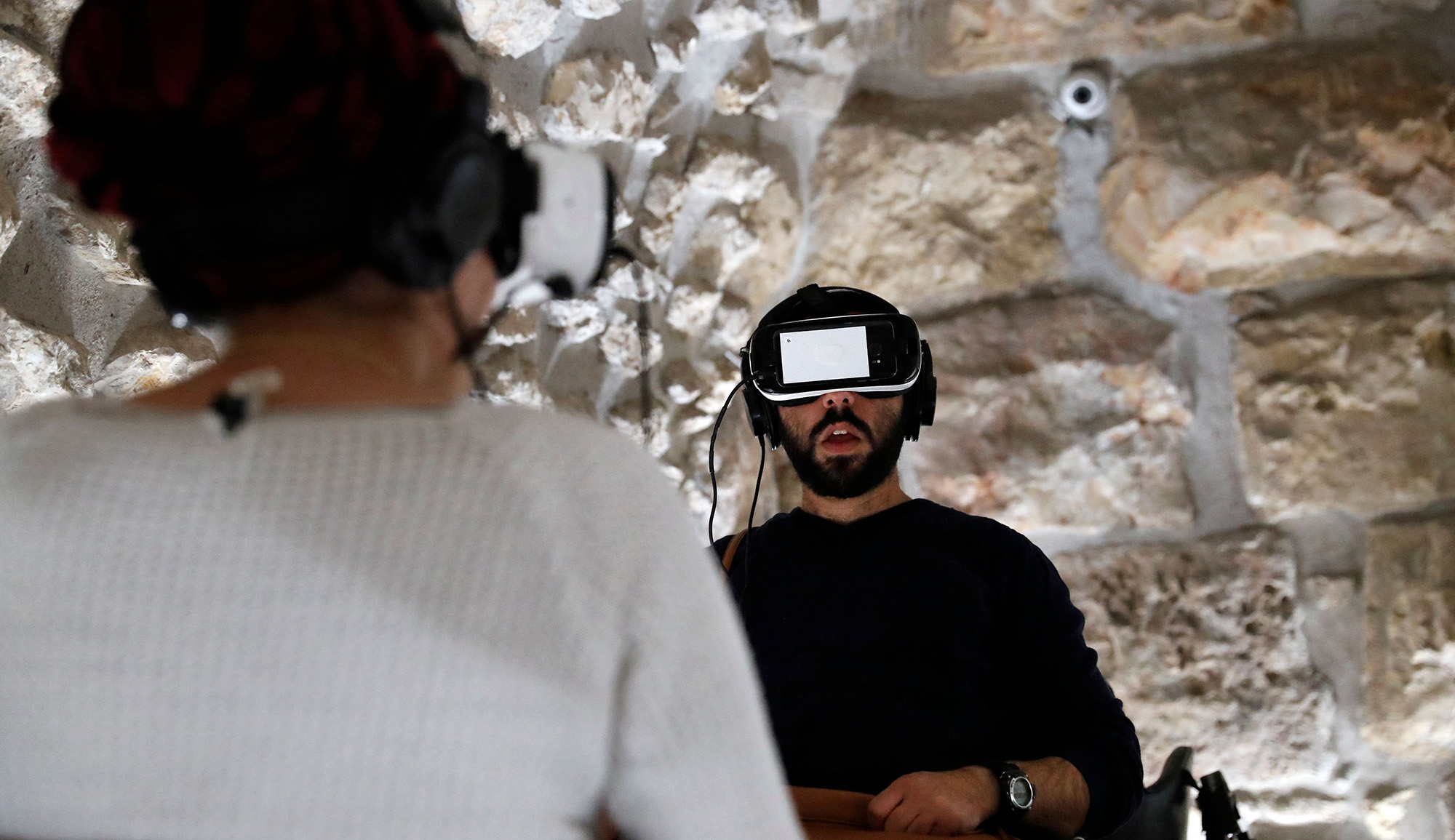I’m very grateful to Moshe Koppel for his intriguing essay about artificial intelligence and Judaism. The essay, written by the rare individual who knows both AI and Jewish law from the inside, forced me to think about the various ways that halakhah (commonly translated as Jewish law) will have to grapple with new technology. Koppel addressed a broad range of topics, but I want to zero in on his assertion that halakhah is better suited than most systems to handle this new world, an issue on which I have somewhat less confidence than he does.
When most of us think of AI, we think of robots and ChatGPT or Google Gemini and the sentient supercomputers of science-fiction movies. We may get some of these things. But AI, as Koppel explains, is a way to describe advanced computing powers that will open up all kinds of technological frontiers that may seem more mundane but could be no less consequential. Though a novice to this subject, I already see how artificial intelligence accelerates social and technological processes from a pace measured in generations to one measured in years. It scrambles existing categories and conceptions at a rate that stresses our ability to reach the social consensus needed to absorb the new reality into existing paradigms. It will lead to rapid advances in already-destabilizing fields like genetic engineering and DNA manipulation, forcing us to grapple with issues that prior infrastructure and technology submerged.
In the wake of such changes, rabbinic decision-makers and observant Jews will be forced to ask themselves not about the how of halakhah but about the why. And that framing is at least as likely to lead to difficulty or even schism as to the comfortable consensus-based halakhic reasoning outlined by Koppel.
Koppel contends that several features of traditional Judaism will give its adherents an advantage in navigating the upheaval that AI will bring. Key to his case is the example of Shabbat. Forced to unplug from machines, Sabbath-observant Jews devote one day each week to old-fashioned activities such as prayer, family and friends, in-person community building, and book-based Torah study and reading—all of which serve as antibodies to ruptures in the social and moral fabric wrought by AI. On this point we are in full agreement.
Koppel goes further, however. In his view, the case of how Jewish law has adapted Shabbat regulations to keep up with the shifting technological landscape illustrates halakhah’s ability to draw wisdom from ancient sources. It also demonstrates its method of patiently reaching decisions grounded in the concrete morality of particular situations, what in lawyer’s terms could be called a common-law approach. This is contrasted with systems based on abstract or theoretical thinking, and especially the utilitarian ethics of the effective altruists, which Koppel reflexively distrusts. This system is more akin to legislation because it seeks to impose the most efficient solutions on society from above.
Koppel frames the central dilemma posed to Shabbat observance by advances in automation well: if we are too lax, the emerging world of “smart” devices will render Shabbat law meaningless. If we are too strict, life in a digitized AI-driven world becomes impossible as Shabbat observers will huddle motionlessly in their homes to avoid triggering the countless cameras and sensors that will soon dominate the physical environment. The response has been a common-law-style application of talmudic precedents and technical halakhic language in search of the “sweet spot” between having enough restrictions to keep Shabbat distinct from the weekdays and sufficient license to make it livable. Though it is hard to draw unambiguous lines on every particular issue, Koppell has confidence that “multiple approaches can and will be tried and the ones best adapted will survive.” This process allows “Shabbat to sustain its role in fostering genuine and direct human connection.”
This example is as good as far as it goes. Indeed, it comports with what I wrote in my 2020 essay for this magazine about the controversy that erupted during the first Passover of COVID over whether seders could be conducted over Zoom despite the restrictions of the holiday. There I too concluded that Shabbat stands as one of the most successful adaptations of halakhah for the modern, and now digital, world. The problem with Koppel’s argument, however, is that this success may have less to do with the nature of Jewish law as such, and more to do with the particulars of Shabbat law that may not translate to other areas.
Common law evolution by trial and error is best suited to situations where development proceeds in incremental steps, when the underlying community has time to adopt and adapt to changes in the regime, and most importantly, when there is a strong consensus on the overall goals of the regulations. When these conditions obtain, the results are interpreted as an embedded and nearly natural evolution of a legal and intellectual tradition.
This is arguably close to the case of Shabbat law. The questions of processes that occur automatically on Shabbat have been the subject of halakhic analysis since Beit Shammai and Beit Hillel debated the issue early in the mishnaic era. Koppel’s essay showcases the longstanding tradition of bringing these issues to bear on successive waves of automation. Beyond these legal resources, Shabbat law was able to transition smoothly to the automated world because of a strong social consensus regarding what it should accomplish in this new reality.
Thus for the better part of a century, rabbis have been arguing over which talmudic paradigm is best suited to governing the use of electricity on Shabbat. Though no clear consensus has emerged at the level of technical halakhic doctrine, Shabbat law has not suffered owing to the very strong social consensus around the view that electricity—and more recently the broader basket of things we call “tech”—is antithetical to Shabbat. In popularized form, they are not Shabbosdik, or Sabbath-like. From rabbis on down, everyone understands that allowing tech to take over Shabbat will kill it; the precise legal reason why matters less. This stable sense of what Shabbat law should yield generates the sense of continuity Koppel articulates. It also provides rabbis with the space to finesse the boundaries of practice in case-specific terms while obviating the need to tackle head on the questions of how to “optimize” Shabbat regulations for the digital age.
But what happens when a technological or social innovation creates more rupture with the past and draws on questions about which there is less social consensus? Take, for instance, the laws governing kosher food consumption, which along with Shabbat are some of the most concrete aspects of day-to-day observant living, demarcating observant Jews from the rest of society.
Scientists have already found that AI is a powerful tool for finding the best ways to manufacture artificial substances of every kind. Others are putting it to use to master protein folding, a complex biochemical process performed with ease by living cells but until now extremely difficult to replicate in the laboratory. Soon (if not already), AI will enable the production of food compounds that wholly challenge our understanding about what food is and thus what kashrut entails. The lab-grown meat that is just on the horizon will make today’s Impossible Beef seem like the pea and soy patties from a generation ago. As advanced computing allows major foodstuffs to be created in radically new ways—for instance by growing meat and vegetables from modified DNA—standard halakhic categories will become increasingly less useful.
To illustrate: the Talmud states a principle that “anything that comes from x shares the same identity as x.” This led rabbis in the early stages of lab-grown meat production to place considerable emphasis on the biological source of the genetic material used for the food in question. This reasonable-sounding rule aims to carry over a semblance of the prior world into the new one by ensuring, for example, that there will never be kosher lab-grown pork. But suppose the original DNA for the ersatz beef is derived from cow’s milk? Does that make this “meat” dairy? Or what if the original source DNA is itself created in a lab? The DNA principle—and other rules like it—eventually break down.
In contrast to the consensus that has emerged around modern Shabbat law, these food-related questions immediately force us to ask: what is the purpose of kashrut? How much of it is about refraining from consuming particular substances, and how much of it is about binding Jewish communities together while separating them from non-Jews? In other words, what makes something kosherdik? The fact that no such word exists demonstrates that to date kashrut has been understood within Orthodoxy more as a series of rules rather than as a system that conveys a particular ethos. But AI-generated foods will put this latter issue directly on the agenda. Indeed, we can see the Orthodox Union’s refusal to certify the wholly plant-based “Impossible Pork” alongside its removal of kosher certification from Herr’s “Roast Pork Sandwich” flavored potato chips as initial attempts to map out the norms of this new territory. Notably the OU still confers kosher status on the Bac’n Bits that came to market more than 30 years ago.
The group of regulations understood today as “keeping kosher” derives from two separate talmudic tractates, each with a different orientation. Tractate Hullin largely deals with the status and identity of ingredients: what animals (and parts of animals) are kosher and what defects render them unfit; ritual slaughter; mixtures of meat and milk and of kosher and non-kosher ingredients; and the circumstances under which non-kosher status can be transferred to otherwise kosher food (e.g., if a kosher item is cooked in a pot previously used for non-kosher products).
Over the centuries rabbis offered different reasons for the kosher laws. The medieval philosophers Moses Maimonides and Moses Nahmanides provided varying explanations for why kosher foods are more healthful or otherwise advantageous for the body. Others took a moral approach, focusing on a distinction between predators and prey, while kabbalists and Hasidim stressed the harm wrought to the soul by consuming non-kosher items. What these approaches share is an emphasis on the nature of ingredients themselves.
By contrast, tractate Avodah Zarah focuses on relations between Jews and non-Jews. It outlines prohibitions on foods based not on forbidden animals or mixtures, but on the involvement of non-Jews in their preparation and production. These rules govern the status of wine, cheese, milk, bread, oil, and other foods that are handled, cooked, or produced by non-Jews. Because their purpose is to generate greater social separation between Jews and non-Jews by injecting friction in attempts to share in a meal together, these restrictions usually apply even if all the ingredients are otherwise kosher.
Given this duality, one might suppose the way forward is simple. Kashrut in the age of AI will eliminate most concerns over the identity of what is being eaten, yet retain restrictions based on the identity of who makes it and with whom it is eaten.
Post-talmudic halakhah, however, has tended to blur these categories and precludes such a neat division. And here is where the case-specific and common-law aspects of Jewish law Koppel celebrates tend to complicate matters as we look to the future. When it comes to restrictions based on cultural separation, Ashkenazi jurisprudence relies extensively on loopholes and leniencies to weaken their impact. Thus, the prohibition on eating food “cooked” by a non-Jew can be solved so long as a Jew plays a minor part in the process—say, turning on the grill, oven, or even a pilot light. Even the prohibition on “Gentile wine,” the strictest of these regulations, has essentially been transformed from a social restriction into a technical one based on the source of the product. Mainstream practice allows wine to be drunk together with non-Jews so long as it has been “flash pasteurized,” a process that leaves a negligible impact on the wine perceptible only to sophisticated palates. A visit to any one of the new high-concept glatt kosher restaurants may reveal a non-Jewish chef trained in the best kitchens serving fine wine and meat to strictly observant patrons dining together with their non-Jewish friends—all certified by exacting kashrut agencies in full compliance with mainstream halakhah.
Yet as these leniences developed, social separation from non-Jews was maintained through adopting successive waves of strictures regarding the provenance of ingredients, and especially the degree to which kosher food items can become contaminated through contact with kitchen equipment used to prepare non-kosher food. From a purely halakhic perspective, the issues that today make it difficult for Jews and non-Jews to share meals stem, paradoxically, from the laws governing the identity of the food itself rather than those meant to enforce social isolation.
Because the social-separation function of kashrut law has largely been accomplished through ingredient-based restrictions, where does that leave us in imagining the observance of kashrut in a high-tech future? We could read existing halakhah to assume that so long as the ingredients are technically kosher, the social aspects are of minimal concern. This would result in a world where wine and cheese produced in labs and never touched by anyone are easily made kosher. The barriers to kashrut may become so low that observant Jews living far from major Orthodox communities would have access to the same variety of food found in kosher grocery stores. The increased availability of kosher ingredients, coupled with computerized surveillance techniques that are proven to be more vigilant and accurate than a rabbi, may make kosher restaurants so easy to maintain that Jews and non-Jews would both eat in them without thinking twice. (Though surely chic, high-end artisanal eateries that use only “natural” meat would emerge and remain forbidden). Alternatively, the halakhic trend towards ingredients-based stringency could be read to produce the opposite, so that kashrut would continue to divide Jews from their neighbors. In this version, rabbinic authorities would be attracted to the strictest possible interpretations of the law and require that lab-grown food be produced and consumed under expressly Jewish auspices.
In the absence of consensus about what the laws of kashrut are supposed to achieve, rabbis may have much more difficulty coping with these questions than they ever did with Shabbat. It is not hard to imagine that more conservative rabbis will interpret existing precedent to argue for the more stringent approach, while more liberal rabbis will find justification in the same sources for leniency. Instead of a ground-up consensus that typically emerges over generations, the rapidity of these developments may yield diffusion and schism, especially as the different interpretations over kosher law latch on to existing fault lines between segments of the observant community.
Indeed, because veganism takes the traditional kashrut concerns regarding animal products off the table, the recent experience with vegan restaurants may offer a template as to how kashrut policy may play out in the future. In theory, it should be possible to provide kosher certification to a vegan restaurant with a less comprehensive, and less expensive, inspection apparatus than is demanded for non-vegan kitchens. A handful of certifying authorities have emerged willing to do just that.
But around the same time vegan diets began to take hold in the broader culture, large segments of halakhic society became increasingly concerned about the presence of forbidden bugs in produce. Mainstream Orthodox kashrut policy is thus wary of relying on veganism to lower the burdens of rendering restaurants kosher. When rabbis are asked about the permissibility of vegan eateries, one of the most common responses is “Who is checking the vegetables for bugs?” The result, and possibly the intent, of this hesitancy over ingredients is to make it difficult to comply with kashrut while dining out in settings that are not distinctly Jewish.
Perhaps even more significant than the ideological divides, we may find new geographic cleavages between the two largest Jewish communities. While, outside of Israel, kosher laws function to keep observant Jews bound to a common communal infrastructure and separate from non-Jews, within Israel they mainly serve to reinforce the tribal nature of Israeli society by separating different groups of religious Jews from each other, and religious Jews as a whole from their traditionalist and secular brothers and sisters. Israeli rabbis with an express commitment to national unity may thus greet the possibility of lab-grown food with excitement. If properly designed, AI-inspired innovations could allow for all Israeli Jews to eat together seamlessly while also maintaining the highest standards of kashrut, leading to greater national cohesion and greater observance among the secular. The events of 10/7 will further strengthen the motivation to bring this world forward.
Whether articulated in the language of halakhic details or social policy, this is a future the American rabbinate is more likely to dread than anticipate. A world where kosher food is universally available is one where a critical boundary marker between observant Jewry and non-Jewish society is erased and the value of Jewish communal infrastructure is diminished. There is also a large kosher industry that could lose its reason for existence, and that can be expected to apply pressure in favor of the status quo. These forces will likely lead American rabbis—and Israeli haredi rabbis interested in maintaining the distinctiveness of their communities—to respond differently.
American kashrut law in the early decades of the 20th century was radically decentralized, and had a reputation for corruption, fraud, and fluctuating standards. The industry became more centralized and reliable after World War II, and today all major American Orthodox kashrut organizations have adopted the same baselines and usually rely on each other’s products. It is too early to tell whether lab-grown food will re-fragment the landscape, but the latter outcome is more likely if the underlying social dynamics in Israel push rabbis in different directions than their American counterparts. Though distinguishing between Israel and the diaspora is common to many areas of halakhah, the kosher laws discussed here are not location dependent. Moreover, the frequent movement and deep familial and emotional bonds between Israel and observant American communities will make it difficult to erect firm boundaries between practices permitted in Israel yet prohibited outside.
It may seem odd to focus on artificial meat when dealing with a technology that has such epochal implications as AI. I haven’t done so because I think that kashrut will present one of the hardest cases, but because it presents one that will be easier for observant communities to address. Even experts on artificial intelligence can’t predict the new possibilities that await, and I am certainly no expert. But it is sure to change medical imaging and diagnostics in ways that will challenge how halakhah deals with abortion, end-of-life care, and other issues that are far more charged than the possibility of kosher pork. In all likelihood, it will force us to grapple with what it means to predict, to have emotions, to think, to know, and ultimately, to be human, creating questions not just of practice but of theology and philosophy at a rate that may not lead to the felicitous results envisioned by Koppel.
Difficult as all this may be, the sense of purpose and rootedness found in Jewish tradition is likely to provide some protection against the social, economic, psychological, and even spiritual upheavals that are about to descend on civilization. Jews will respond to this disruption doing what they alway do: arguing through their holy canon and watching the rest of society. But it is difficult to say whether the result will be convergence, schism, or an entirely new set of norms; or whether the Jewish community will address these issues more or less successfully than the rest of society. In fact, I expect considerable debate as to what success will mean.
More about: AI, Artifical Intelligence, Jewish law, Kashrut, Religion & Holidays







